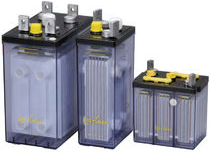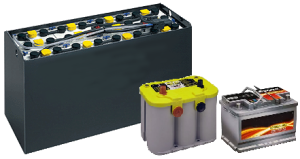
This kind of accumulator is the most common in commerce, pratically
every kind of vehicle with a combustion engine has got one.
The electrodes are made in lead (Pb), the electrolyte is sulfuric acid
(H2SO4).
There are different construction types, with flat plates, with wrapped
plates, with liquid electrolyte, with gel electrolyte, sealed and opened
(with caps for refilling of the electrolyte).
They could be used to realize high current for short time (starter batteries), to give
limited current for long time (UPS batteries) or as buffer solution (low losses and long
period of inactivity).
| 6 | Number of elements for a 12 V accumulator. |
| 2.041 V | No-load voltage of each element with charged battery. |
| 2.4 V | Voltage of an element during charging phase corrisponding to the
production of oxygen and hydrogen (say battery is boiling). |
| 2.7 V | Maximum charge voltage admitted for each elements. |
| 2.75 V | Voltage of an element to which all the energy applied during charging
is not stored but used for electrolysis, partly transformed into heat (the battery boils but it will no longer charge). |
| 1.8 V | Voltage of each elements out of power (subjected to a weak absorption). |
| 1.21 - 1.26 | Density of the electrolyte when charged. |
| 1.15 | Density of the electrolyte when discharged. |
| 0.0025 ohm | Internal resistance of an accumulator by 12 V - 60 Ah (indicating value). |
| 0.0015 ohm | Internal resistance of an accumulator by 12 V - 100 Ah (indicating value). |
| 900 - 1500 | Battery lifetime in terms of charge-discharge cycles. |
| 30 - 40% | Concentration of the sulfuric acid to use for the first use. |

Capacity.
The capacity of the accumulators is the indicator of how much energy can be supplied.
Normally is given in Ah (e.g. 55 Ah) and it is also wrongly called "power", but
really the power is expressed in W.
Hypothetically an accumulator of 55 Ah, charged and in ideal condition, should
give 55 A for an hour, but instead the declared values are almost always referred
to a current of 1/10 of the capacity (e.g. 55 Ah = 10 hours for 5.5 A).
The maximum current suppliable.
It varies referred to the contruction type but generally can be considered as 4-6 times
the nominal capacity, for instance an accumulator of 60 Ah can give peak of current of the order
of 250-350 A.
The maximum current reduces with the decreasing of the temperature, at 0 °C is not improbable
to have the 50% of the current obtainable at 25 °C.
Discharging time.
The discharging time is influenced by a lot of factors such as temperature, internal resistance,
charging time, current ecc...
Surely the given energy will be always lower than the stored during the charging phase.
There are special accumulators realized to provide high currents for short periods and others more suited to
provide limited current but for long times.
In general we say that a battery of 100 Ah, charged and at the temperature of 25 °C has a dischage time of:
This is not strictly true but is useful to make quickly mental calculations, in facts more the current is high and less will be the total energy provided.
The charge.
The recommended charge envisages a current of 1/10 of the capacity for the duration of 12 hours.
For examples a battery of 60 Ah should be charged with 6 A for about 11-12 hours,
12 hours instead of 10 are needed to compensate the efficiency which is lower than 1.
Charging time inferior than 10 hours are possible increasing the
current but beyond a certain limit the battery lifetime is reduced.
It is more advisable to avoid short charging time when you can.
The losses.
Due to inevitable internal losses, the stored energy is slowly consumed by the battery itself.
An accumulator which is not used must be charged once or twice per year, if it remain
low it will be irreversibly damaged.
Measure the battery level.
For what concern the lead battery, measure the voltage without any loads does not give
values proportional to the battery level, pratically is always near at 12 V also when
the battery is pratically low.
If the battery has got caps, the most precisely method is to measure the density of the
electrolyte. When battery is charged it must be at 1.21 - 1.26.
When there are not caps you can use an instrument which applies a load and at the same
time gives the voltage.
The battery charger.
The charge phase envisages an applied voltage greater than the battery voltage.
More the applied voltage is high (respect to the battery one) and higher is the
absorbed current but lower is the charging time.
The best charge mode is with constant current, providing a variable voltage in way to keep current at the set value. A limiter stops the voltage at a maximum of 14.4 - 15 V to reduce the production of gases.
Professional equipments have also a control on time which switch off automatically the battery charger.
The new accumulator.
Normally the lead accumulators are selled dry charged, this method allows the extended
storage without ageing (oxidation of the plates due to inactivity).
To activate them is enough to fill it with sulfuric acid at 30-40% obtaining an
accumulator immediately effective.
In practise is to prefer to charge it for some hours before start to use it or
before take high currents.
Acid level.
Acid internal the elements must always covers the plates to avoid premature damages to
the plates (apart from the lower current available).
Remember that acid volume changes are in function of the charge state of the battery:
Correct operating position.
If the electrolyte is at the right level are admitted tilts angles about 20 °
but normally they must be placed vertically. When the battery is inclined it is more
subjected to vibrations.
Some special batteries allow higher tilt angles for short time.
Sealed batteries with gel electrolyte can work at any orientation.
Things who damage a battery:
Danger: